
Fastening Techniques for Plastic Housings
By Jeff Greenwood, Product Sales Engineer - Pins
General noads
Sponsored by SPIROL
The ups and downs of fastening methods used to assemble plastic components.
Plastics have become more and more common in manufacturing, and there is still plenty of room for growth. As such, Engineers must ensure that new plastic products meet performance requirements while considering component costs and assembly cycle time.
While plastic materials provide many advantages, they can introduce manufacturing challenges during the assembly process that lead to inefficiencies, scrapped parts, and added costs. This article addresses the advantages and disadvantages of the following fastening methods used to assemble plastic components: solid pins, adhesives, screws, bolts, and snap-fit joints.
Serviceable vs Permanent
Before selecting the fastening method, designers must decide if their product needs to be serviceable. For example, products like fire detectors, television remotes, and key fobs must be designed so that consumers can disassemble the product to replace batteries. Conversely, products like hair dryers and single-use medical devices are typically not designed to be disassembled or serviced. Furthermore, some designers will specifically design components to be tamper resistant so that consumers cannot easily disassemble the product (i.e. electronics).
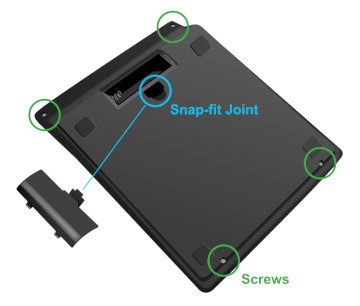
Back of a pocket calculator
Screws, bolts, and snap-fit joints (i.e. plastic buckles) are the most common fastening methods used in serviceable products. Bolts and screws provide a clamp load that compresses the components within an assembly. This is accomplished when the bolt/screw is torqued beyond the point at which the head makes contact with the mating component. Bolts and screws provide superior retention compared to snap-fit joints, which rely on the strength of the plastic component itself.
Snap-fit joints provide retention by interlocking multiple components together. Snap-fit joints can be assembled quickly and they simplify the overall assembly process because there are fewer parts on the bill of materials. Snap-fit joints are often preferred when minimal retention is needed in a plastic product. For example shown in Figure 1, most pocket calculators use snap-fit joints for the battery cover so that consumers can easily change the batteries.
Permanent
Solid pins, adhesives, screws, bolts, and snap-fit joints are all commonly used to fasten permanent assemblies. While designers may not specifically require a new product design to be serviceable, many products still use serviceable fasteners like screws for convenience and operator familiarity. For example shown in Figure 1, most pocket calculators use screws to connect the plastic housing together even though consumers do not need to pull the assembly apart during the useful life of the product.
Solid pins and adhesives are preferred for permanent assemblies that are meant to be tamper resistant because they provide excellent retention in plastics. Adhesives provide retention by binding multiple components together. Meanwhile, solid pins provide retention by deforming the host material, creating interference. Note that solid pins with retention features (i.e. knurls, barbs) are preferred over plain dowels because they allow for wider hole tolerances and reduce stresses on the plastic components.
Tamper resistance helps mitigate the risk of warranties, product damage, or environmental exposure (i.e. moisture, particles). Additionally, serviceable fasteners like screws create a significant safety hazard in products like children’s toys (choking hazard). For these reasons, solid pins and adhesives are typically the preferred fastening options for items that do not require servicing.
Assembly Process & Maintenance
Solid Pins
Solid pins are easily installed with presses, ranging from manual to fully automatic. During the installation process, the press provides a linear force to advance the pin until it reaches a predefined stop distance. Assemblies with multiple pins can use platen-style presses to install multiple solid pins simultaneously.
For these reasons, the assembly cycle time for solid pins is quicker than using screws or bolts. When the components are fixtured and oriented correctly, solid pins also provide the lowest failure rate compared to other fastening methods. The installation equipment used to install solid pins has minimal maintenance requirements.
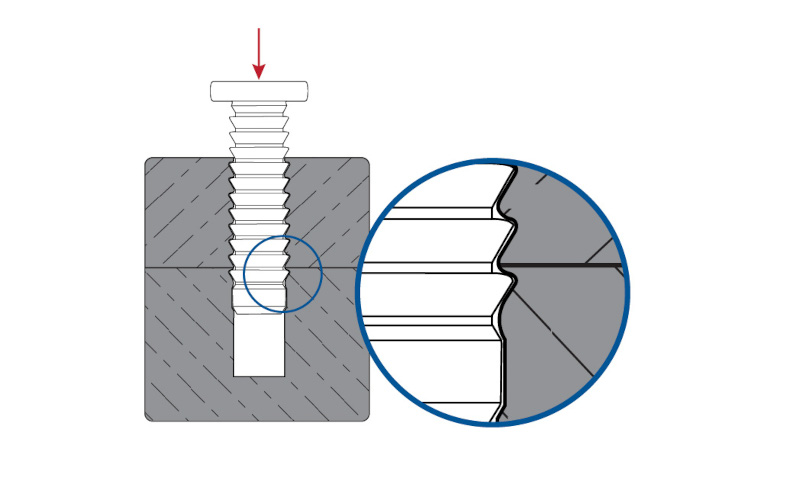
Plastic backfill after installation of barbed Solid Pin
Note that some Solid Pins, like SPIROL’s Press-N-Lok Pin in Figure 3, are designed to be hidden in the final assembly for aesthetics. This allows for the use of blind holes.
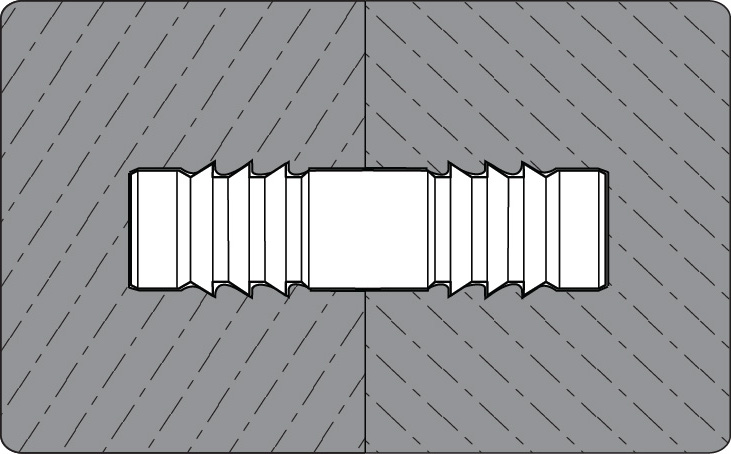
Press-N-Lok Pin cross section
Adhesives
Adhesives can be applied with manual handguns or automated dispensing equipment. Oftentimes, surface preparation is required for the host components. The process of applying the adhesive during assembly is quite complicated and requires skilled operators. If too little or too much adhesive is applied to a single assembly, it can lead to field failures.
Furthermore, many adhesives require temperature control, pressure control, and/or the controlled mixing of different fluids prior to contact with the host components. After the adhesive is applied, there is a curing process that in some cases can extend beyond 24 hours!
The installation equipment for adhesives requires extensive maintenance and monitoring, as adhesives are messy and the equipment can clog if contaminants are introduced. In addition, many adhesives have a limited shelf life. All of this adds costs and complexity to the assembly process and also reduces machine availability. With so many variables involved, repeatability and control can be challenging.

Misaligned Screw
Screws tap into the host component and can be installed with handheld torque screwdrivers or fixtured automatic screwdrivers. Both types of screwdrivers rotate the screw to a specified torque value. It’s important to recognize that this is considerably more complicated than the installation process for solid pins. Manufacturers can experience issues orienting the screws to the driver bit and holding the screws in place.
If the screws are not perfectly aligned, they can strip the host plastic and cause scrapped assemblies. Another common issue when installing screws directly into plastic is that they can become loose over time due to plastic creep or stress relaxation. While screws are inexpensive, readily available, and familiar for operators, they present manufacturing challenges during assembly.
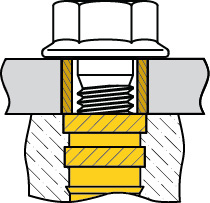
Ideal Bolted Joint
Bolts function similarly to screws, only they thread into a nut or metal threaded insert instead of the plastic host. Bolts provide the greatest retention among the options in this article and allow for unlimited assembly and disassembly (without damaging the plastic) when used in conjunction with a nut or threaded insert.
A properly bolted joint in a plastic component will use three separate components: the bolt, a compression limiter, and a nut or threaded insert. This adds complexity and cost to the bill of materials as well as the assembly process. Bolts should be avoided unless the desired clamp load cannot be achieved with alternate fastening methods.
Snap-fit Joints
Snap-fit joints are typically assembled manually by pressing components together. The assembly process for snap-fit joints can vary significantly depending on the design of the interlocking components. Some snap-fit joints are designed to be serviceable while others are designed to be permanent. By using snap-fit joints, manufacturers are minimizing the total number of parts used per assembly.
Ultimately, this reduces costs, inventory, and handling. However, snap-fit joints provide lower retention than other fastening methods, as snap-fit joints rely on the strength of the plastic components themselves. Snap-fit joints are preferred for assemblies that are exposed to minimal loads. However, snap-fit joints are prone to failure and can create environmental hazards like choking hazards.
Features, Advantages, Benefits
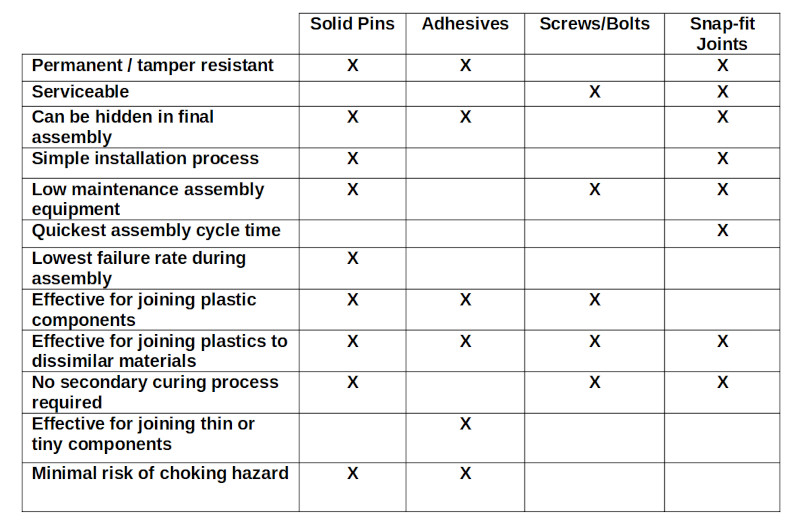 Designers must consider performance, simplicity, fastener costs, and the cost of assembly when designing plastic housings. It is recommended that the design engineers work with the manufacturing engineers early in the design stage so that the total assembly process is considered. Far too often, new product designs are finalized without considering assembly cycle time, scrap rate, maintenance costs, and consumer behavior throughout the product’s useful lifetime.
Designers must consider performance, simplicity, fastener costs, and the cost of assembly when designing plastic housings. It is recommended that the design engineers work with the manufacturing engineers early in the design stage so that the total assembly process is considered. Far too often, new product designs are finalized without considering assembly cycle time, scrap rate, maintenance costs, and consumer behavior throughout the product’s useful lifetime.
www.spirol.com
